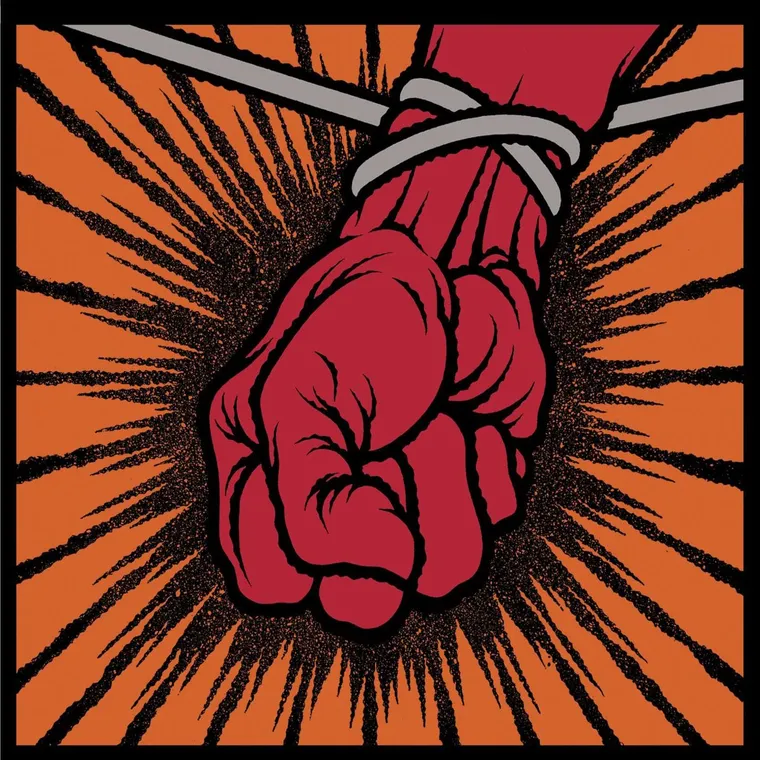June 5, 2025 – St. Anger didn’t arrive to unite the faithful—it arrived to divide them. Released in 2003, it wasn’t a return to form or a step forward. It was a scream from the gut, raw and ragged. Where other bands reinvented themselves with polish or pandered to the charts, Metallica descended into themselves and pulled up a twisted, bleeding portrait of collapse and catharsis. This was not trash. This was not groove. St. Anger was metal stripped of everything—solos, subtlety, sheen—and laid bare.
If Master of Puppets was a symphony of destruction and The Black Album a monument of dominance, St. Anger was the crumbling fortress. Not a fall from grace, but a public demolition. Ugly, brave, essential.
It wasn’t a rebirth. It was a rupture.
Fracture and Fire
The opening blast of “Frantic” is jarring—not just because of the production, but because of its intent. There’s no build-up. No warm welcome. Just a violent, twitching riff and James Hetfield barking with manic urgency. The infamous clanging snare drum—so divisive, so abrasive—doesn’t feel like a flaw here. It’s a design choice. A statement. It’s a tin can warning of a band under pressure, barely holding together.
“My lifestyle determines my deathstyle,” Hetfield roars, and it’s not posturing. It’s panic. It is the sound of a man trying to outrun himself, the sound of a band realizing the machine might be broken beyond repair. And yet, instead of fixing it, they turn the mics on and record the wreckage in real time.
“St. Anger,” the title track, follows with grinding simplicity and primal repetition. The chorus isn’t catchy—it’s cathartic. It doesn’t rise. It burns. Metallica isn’t interested in elegance anymore. It isn’t about the riffs. It’s about release.
Solos Abandoned, Honesty Embraced
Perhaps the most controversial decision on St. Anger was to omit guitar solos. For a band built on iconic leads—from “Fade to Black” to “One”—it seemed unthinkable. But here’s the truth: solos would have ruined this album. There’s no space for them. No room for flair when the wounds are still open.
St. Anger is not a guitarist’s record. It’s a human one.
Kirk Hammett’s contributions are textural, sometimes buried beneath walls of rhythm, distortion, and noise. And it works. Because St. Anger isn’t meant to impress. It’s meant to exorcise. It captures Metallica in their most unrefined form, right in the eye of a personal and creative storm.
The Therapy Sessions Set to Riff
To understand St. Anger is to understand its context: the band nearly imploding, James entering rehab, Jason Newsted walking out, and a film crew documenting it all (Some Kind of Monster). The album was composed in the furnace of group therapy—something no metal band had dared to drag into the studio before.
That discomfort is everywhere. “The Unnamed Feeling” is perhaps the most visceral display of emotional unease Metallica has ever put to tape. The lyrics crawl with anxiety. Hetfield doesn’t sing so much as unravel, swinging between detachment and desperation.
“Some Kind of Monster” isn’t so much a song as a séance. Eight minutes of slow-burn rage and repression boiling over into unfiltered release. It’s heavy in a way that transcends tempo. There’s no finesse—only burden. “These are the cries from the monster,” Hetfield confesses, and you can almost hear the walls closing in.
Steel, Sweat, and Sound Design
Much ink has been spilled over the album’s production, courtesy of Bob Rock—who also played bass during recording. The drum sound, intentionally unorthodox, is abrasive and metallic. The guitars lack the multi-layered crunch of past albums. The mix is dry, sometimes claustrophobic, and entirely deliberate.
Rather than crafting something slick, Metallica created an audio diary. The snares clang like oil drums. The bass thrums like steel cables under strain. The guitars are jagged and smeared, never quite locking into place. It all sounds unstable because they were unstable. And that’s what makes St. Anger so fascinating.
Where most albums aim for sonic perfection, St. Anger is a risk—a declaration that imperfection can be power. The band wasn’t just recording music. They were documenting the meltdown. It’s ugly by design. And that design holds up better than many once thought.
No Mask, No Mercy
There’s a kind of genius to St. Anger’s refusal to be accessible. It doesn’t invite you in. It shoves you into the room and locks the door. It’s not interested in being liked. It’s interested in being real. And in that, it has aged far better than many of its slicker contemporaries.
“Shoot Me Again” is defiant and deliberately self-aware, playing with violence and self-loathing in equal measure. “My World” teeters on the edge of total collapse, its jagged structure mirroring a shattered psyche. “Invisible Kid” runs long, but every minute is soaked in emotional fatigue and a desire to claw out from underneath addiction, doubt, and regret.
Even “All Within My Hands” feels more like a breakdown than a sendoff. Its quiet-loud dynamic escalates into Hetfield screaming, “Kill! Kill! Kill!”—not in violence, but in a desperate attempt to destroy the very thing dragging him under. It’s disturbing. And it’s effective.
Standout Tracks:
Frantic
St. Anger
The Unnamed Feeling
Dirty Window
Some Kind of Monster
All Within My Hands
A Decade of Doubt, Two Decades of Truth
St. Anger was never meant to be understood on first listen. It’s too raw, too messy, too personal. But time has been kinder to it than critics ever were. In 2003, it sounded like chaos. In 2025, it sounds like courage.
The album wasn’t Metallica at their strongest. This was Metallica surviving. Stripped of myth, stripped of ego, they gave us the ugliest album in their catalog—and, arguably, the most honest.
It’s not a masterpiece in the conventional sense. But it’s necessary. For them. For us. For heavy metal to remember that sometimes, the most powerful thing a band can do isn’t dominate—it’s bleed.
St. Anger wasn’t Metallica’s fall.
It was their reckoning.

